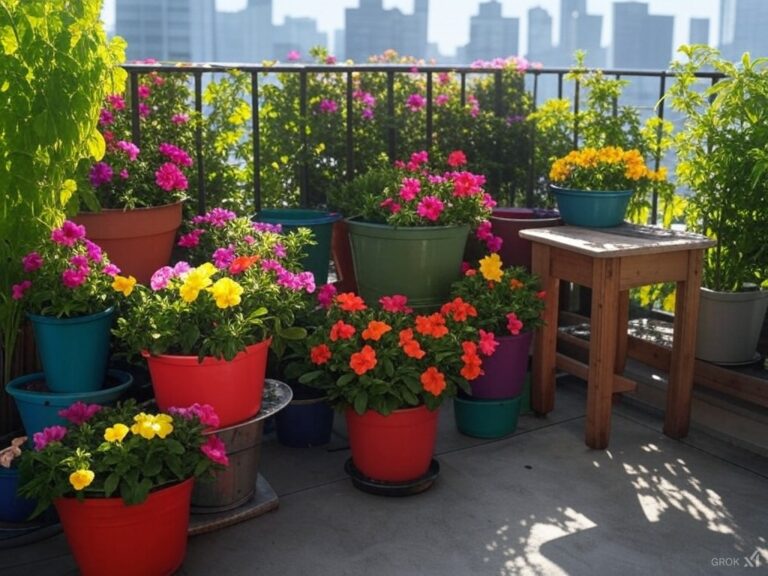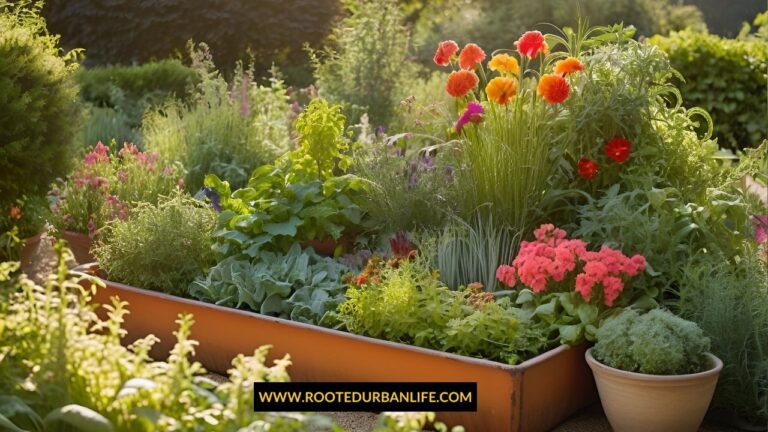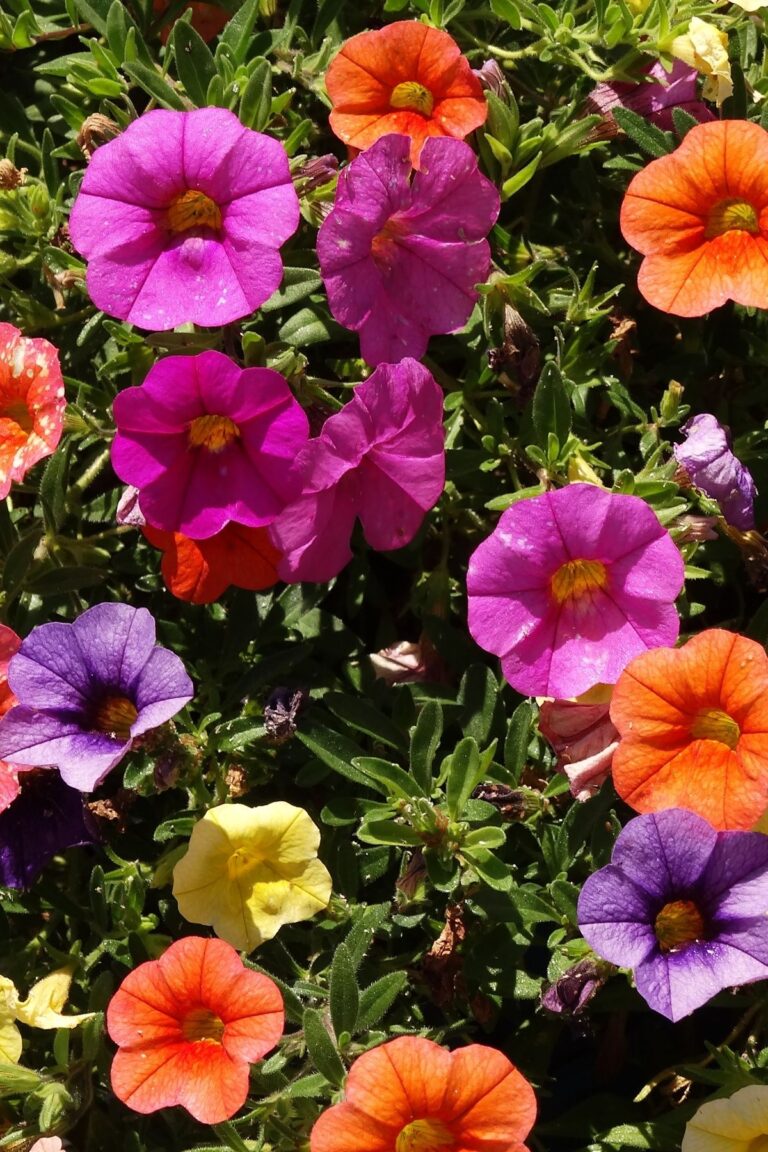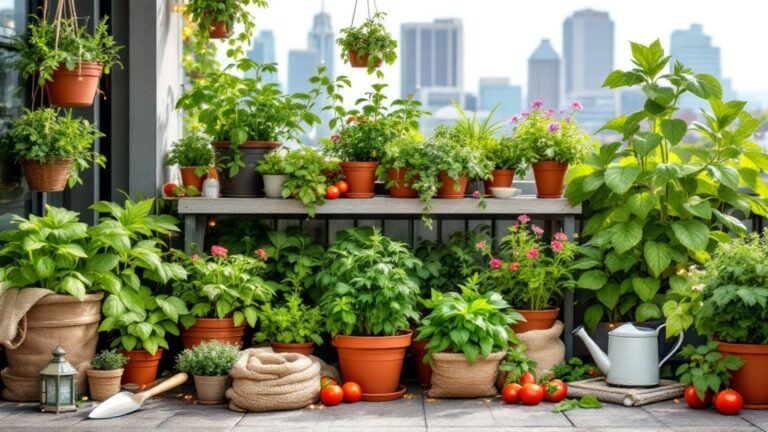Winterizing Your Balcony Garden: Essential Steps to Prepare for Cold Weather
Ever wandered if your plants will survive the winter? Winterizing your balcony garden is essential for its survival and health. You can protect your plants and ensure they thrive come spring by following a few key steps.
With the right techniques and care, your garden can withstand the cold months ahead.
Read more: Winterizing Your Balcony Garden: Essential Steps to Prepare for Cold WeatherOften, balcony gardens face unique challenges in winter, such as limited shelter and exposure to harsh conditions.
Assessing your garden’s specific needs will help you make informed decisions on how to winterize effectively.
By selecting the right plants and utilizing proper techniques, you can keep your garden vibrant throughout the season.
Don’t wait until the first frost to take action. Follow the best practices to ensure your balcony garden is ready for winter and comes back strong when warmer weather returns.
A little preparation now goes a long way in protecting your plants and enhancing your gardening experience.
| Winterizing your balcony garden involves assessing plant sensitivity and microclimate, insulating with covers or mulch, adjusting watering practices, and choosing hardy varieties. Regular maintenance, including pest management, is very important. By implementing these strategies, you’ll protect your plants from harsh winter conditions, ensuring a thriving garden come spring. With proper care and preparation, your balcony garden can survive and thrive even in the coldest months. |
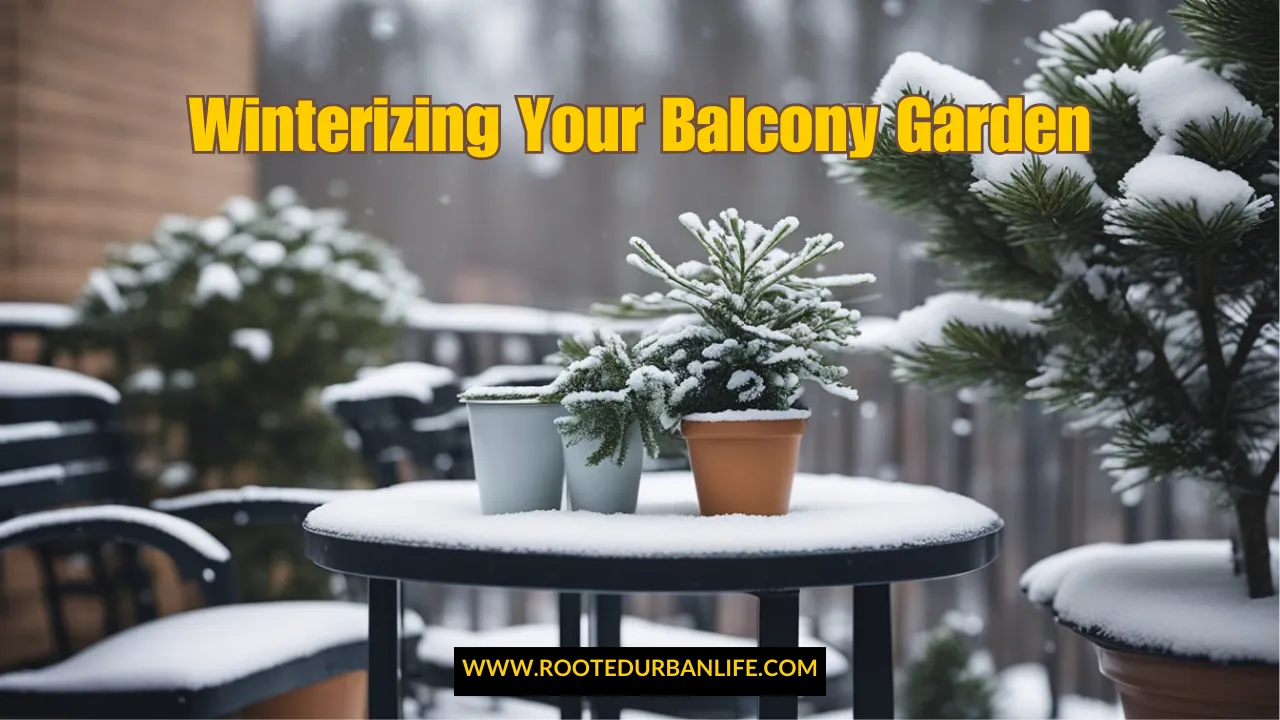
Winterizing Your Balcony Garden
Impact of Cold Weather on Plants
Cold weather has several effects on your balcony plants.
- Many plants can suffer from frost damage, which occurs when temperatures drop below freezing. This can cause leaves to turn brown and stems to wilt.
- Some plants go dormant in winter, slowing down their growth. This is normal, but you need to ensure they get enough protection during this time.
- Wind can also dry out plants, especially those in smaller containers.
- Watering needs can change in winter. It is important to monitor moisture levels because overwatering can lead to root rot, while dry soil can stress the plants. Consider using mulch to help retain moisture.
Benefits of Winterizing
Winterizing your balcony garden offers many advantages.
- It helps protect your plants from harsh weather conditions. Covering them or bringing them indoors can reduce the risk of frost damage.
- Winter preparation can improve plant health for the spring. By trimming dead leaves and cleaning containers, you can prevent pests and diseases. This makes it easier for your plants to bounce back once warmer weather arrives.
- Winterizing can save time and effort later. When plants are properly cared for during winter, they are less likely to require extensive care come spring. This simplicity allows you to enjoy your garden with less hassle.
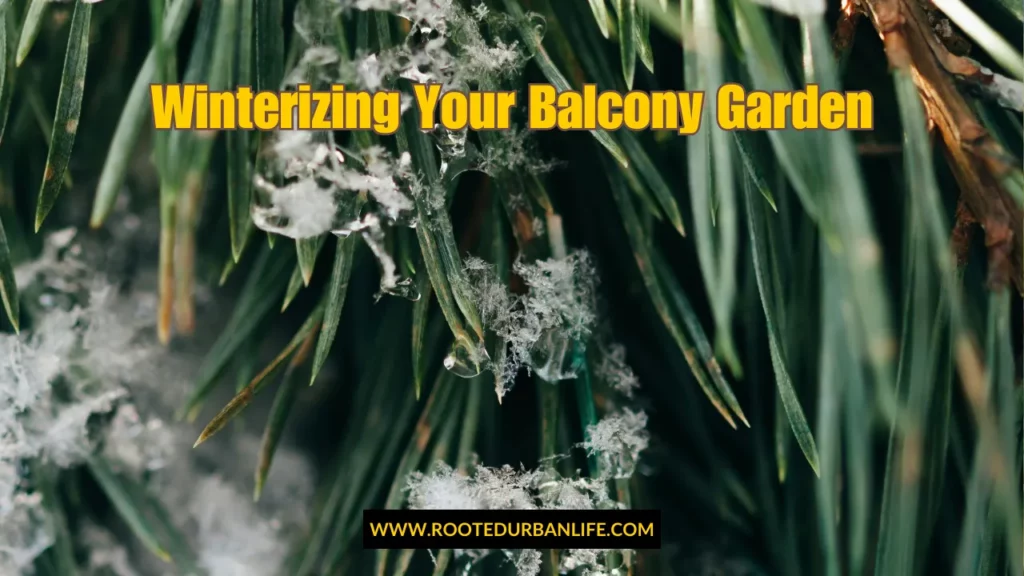
Assessing Your Balcony Garden’s Needs
Preparing your balcony garden for winter requires careful evaluation. You need to think about how each plant handles cold and the specific conditions on your balcony.
Evaluating Plant Sensitivity
Start by listing all your plants and their sensitivity to cold. Some plants, like succulents and certain herbs, can handle mild freezes. Others, such as tropical plants, may not survive temperatures below 50°F (10°C).
Here is an example. Remember to always check your specific conditions and gardening zone.
| Plant Type | Hardy (Winter-Resistant) | Not Hardy (Winter-Sensitive) |
|---|---|---|
| Herbs |
|
|
| Flowers |
|
|
| Vegetables |
|
|
| Shrubs |
|
|
| Succulents |
|
|
Brought to you by rootedurbanlife.com
Once you know which plants are hardy, you can decide how to protect your less hardy varieties. You might want to bring some indoors or cover them with frost cloths. Taking time to assess their needs can make a big difference in outcomes come spring.
Considering Microclimate Factors
Your balcony’s conditions will affect how you prepare your plants. Consider factors like sunlight, wind, and exposure to harsh weather. For example, a south-facing balcony may retain more heat than one that faces north.
Key microclimate factors:
- Sun exposure: Less sunlight means colder conditions.
- Wind protection: Wind can dry out plants and lower temperatures around them.
- Shade: Buildings or awnings can create cooler spots.
Take note of where your plants are located. Adjusting their positions based on these factors can help protect them from the winter chill. For the best results, make a plan based on your unique balcony environment.
Essential Winterization Techniques
Preparing your balcony garden for winter is crucial to protect your plants and promote healthy growth in the spring. Focus on insulating your plants, adjusting watering routines, and improving soil conditions.
Insulation and Covering Strategies
To insulate your plants, consider using materials that trap heat. Here are some effective methods:
- Fleece Plant Covers: Lightweight and breathable, they protect against frost while allowing light and air in.
- Bubble Wrap: Use this around pots for added insulation. It absorbs heat during the day and releases it at night.
- Row Covers: These are great for larger plants. They create a mini-greenhouse effect, keeping temperatures higher.
Make sure to secure any covers properly to prevent wind damage. Remove coverings during sunny days to prevent overheating.
Watering Best Practices
Watering needs change in winter. Here’s how to adjust your routine:
- Less Frequent Watering: With cooler temperatures, plants will not use water as quickly. Water your balcony garden less often, but check soil moisture.
- Time of Day: Water in the morning when temperatures are mildly warm to reduce the risk of freezing overnight.
- Use Room Temperature Water: Cold water can shock roots. Fill your watering can with water and let it reach room temperature before use.
Avoid watering if frost is expected, as it can lead to root rot.
Soil and Mulching Solutions
Good soil health helps your plants survive winter. Consider these strategies:
- Add Organic Matter: Incorporate compost or aged manure into the soil. This enriches it and provides nutrients to your plants.
- Mulching: Apply a thick layer (about 2-4 inches) of mulch around your plants. Use straw, wood chips, or leaf mold to retain moisture and regulate temperature.
- Check Drainage: Ensure your pots have good drainage to prevent water accumulation, which can freeze and damage roots.
These techniques will promote a stable environment for your balcony garden during the cold months.

Choosing the Right Plants for Winter
Selecting the right plants is crucial for your balcony garden’s success during winter. Some plants can thrive in colder temperatures, while others may need special care. Focus on hardy varieties and consider adjustments for seasonal changes.
Hardy Plant Varieties
When choosing plants for winter, opt for hardy varieties. These plants can withstand frost and colder temperatures. Examples include:
- Pansies: Colorful blooms that can survive freezing temperatures.
- Kale: Edible and offers vibrant colors, especially after frost.
- Perennials: Such as sedum and heuchera, which return each year.
You can also consider evergreens like boxwood or juniper for year-round greenery. They add structure to your garden even in winter. Check the hardiness zone for each plant to ensure they can thrive in your climate.
Seasonal Plant Adjustments
As the weather changes, make necessary adjustments to keep your garden healthy.
- Insulate your pots. This can be done with burlap or bubble wrap to protect roots from freezing.
- Adjust watering routine. Plants need less water in winter. Water them thoroughly, but allow the soil to dry out before the next watering.
- Consider moving pots to a sheltered area. This will shield them from harsh winds and extreme cold. Grouping pots together can create a microclimate that helps protect from chill.
Maintaining Your Winterized Balcony Garden
After winterizing your balcony garden, it’s important to keep up with regular care. Routine checks and pest management are essential to ensure your plants stay healthy during the colder months.
Routine Checks and Care
You should inspect your plants regularly. Look for any signs of stress like browning leaves or wilting. Check soil moisture too; overwatering is a common issue in winter.
- Watering: Water less often in winter. Ensure pots have drainage holes to prevent root rot.
- Light Exposure: Rotate your plants if they need more sun. Move pots closer to light sources if possible.
Fertilizing can be reduced during winter. Plants aren’t growing as much, so they don’t need as many nutrients. Use a diluted fertilizer if you choose to feed your plants.
Pest and Disease Management
Pests can still be a problem in winter. Regular checks help catch issues early. Look for common pests like aphids or spider mites.
- Prevention: Keep your balcony clean. Clear away dead leaves and debris that can attract pests.
- Treatment: If you find pests, use insecticidal soap or neem oil. These treatments are less harsh and safer for your plants.
Additionally, monitor for any signs of disease, such as spots or mold. Remove affected leaves to stop the spread. Being proactive keeps your garden healthy even in winter.
Common Mistakes to Avoid When Winterizing Your Balcony Garden
- Improper Pruning: Avoid heavy pruning in late fall, as it can stimulate new growth vulnerable to frost damage.
- Neglecting Plant Nutrition: While growth slows in winter, some plants still need nutrients. Use a balanced, slow-release fertilizer before winter sets in.
- Forgetting to Clean Tools: Clean and disinfect your gardening tools before storage to prevent spreading diseases next season.
- Ignoring Indoor Pests: If you’ve brought plants indoors, check them regularly for pests that thrive in warmer, drier indoor conditions.
- Overlooking Hardiness Zones: Don’t assume all plants labeled as “hardy” will survive your specific winter conditions. Research your local hardiness zone.
- Forgetting to Harvest: Harvest any remaining fruits, vegetables, or herbs before the first frost to prevent waste and potential pest attractions.
- Neglecting Winter-Blooming Plants: Some plants bloom in winter. Don’t forget to care for these cold-season stars of your balcony garden.
- Improper Storage of Summer Bulbs: If you have summer-blooming bulbs, remember to dig them up, dry them properly, and store them in a cool, dry place.
By avoiding these often-overlooked mistakes, you’ll ensure your balcony garden is fully prepared for the winter season and ready to thrive when spring arrives.
Frequently Asked Questions
Preparing your balcony garden for winter involves several important steps. You’ll want to know how to protect your plants, what materials you need, and when to start this process.
What steps should be taken to protect balcony plants from frost?
To protect your plants from frost, move potted plants closer to the house. Cover them with blankets or frost cloth at night when temperatures drop. You can also use mulch to insulate the soil.
Can balcony gardens survive the winter months, and how?
Yes, balcony gardens can survive winter. Some plants are hardy and can withstand cold temperatures. You can also insulate containers and provide shelter to help them endure the winter.
What are the best plants for a balcony garden in winter?
Good winter plants for a balcony include evergreens, ornamental cabbage, and hibernating herbs like thyme and rosemary. These plants can handle cooler weather and will add color to your space.
How do you provide adequate insulation for balcony garden containers?
To insulate containers, use materials like bubble wrap, foam, or straw around the outside. You can also elevate pots off the ground to prevent freezing from below.
What materials are needed to winterize a balcony garden?
You will need mulch, frost cloths, insulating materials, and possibly stakes for covering larger plants. Having pots with good drainage will help prevent water from freezing inside.
When is the right time to start winter preparation for a balcony garden?
Start preparing your balcony garden for winter in late fall.
Pay attention to local weather forecasts to time your preparations before the first frost.
Key Takeaways
| Start early by assessing your plants’ needs and your balcony’s unique conditions. Use insulation techniques like covers and mulch to protect against frost. Adjust watering and fertilizing routines for colder weather. Choose cold-hardy plants when possible, and group containers for extra warmth. Regular maintenance and pest checks throughout winter will ensure a healthy, vibrant garden year-round. |
Winterizing your balcony garden helps your plants survive the cold months and thrive when spring arrives. By understanding their needs, assessing your balcony’s microclimate, and implementing effective winterization techniques, you can maintain a vibrant and healthy garden year-round.
The key to success lies in preparation, regular care, and adapting to your unique balcony environment.
Ready to get started? Grab your gardening gloves and get started today! We’d love to hear about your winterizing experiences – share your tips, challenges, or success stories in the comments below. Have questions? Ask away! And don’t forget to subscribe to our blog for more seasonal gardening advice and inspiration. Together, let’s keep our balcony gardens thriving all year long!
Other Posts You Might Enjoy
How To Start A Balcony Herb Garden



